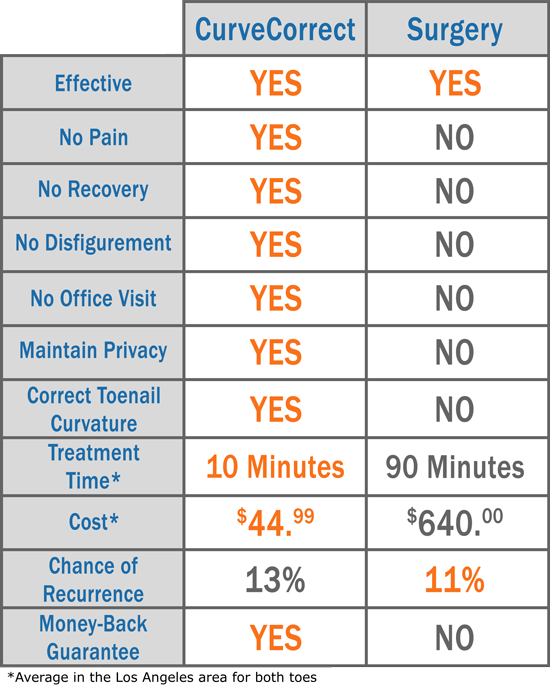Ingrown toenail surgery involves various procedures either on the nail itself, the nail matrix, or the skin surrounding the ingrown nail. An ingrown toenail represents a condition in which the nail grows into the skin at the sides of the nail. It's a common nail disease. It occurrs most often on the big toe but may occur on the other toes. There are three main stages of the ingrown nail. Stage one and some milder cases of stage two ingrown toenails can be treated using various home treatments and non-operative methods. More severe stage two ingrown toenail cases and all cases of stage three should be treated operatively.
Stage One
Stage one is the inflammation stage. The toe is swollen, pink and sensitive to pressure along the side of inflammation.

Stage one of ingrown toenail, DermNet NZ. Ingrown toenails. DermNet NZ, 2013. Available from: www.dermnetnz.org/hair-nails-sweat/onychocryptosis.html (Accessed July, 2016).
Stage Two
Stage two is the abscess stage. It is characterized by edema (collection of fluid in the area), redness, greater pain when we apply pressure on the toe and drainage of secretion.

Stage two of ingrown toenail, DermNet NZ. Ingrown toenails. DermNet NZ, 2013. Available from: www.dermnetnz.org/hair-nails-sweat/onychocryptosis.html (Accessed July, 2016).
Stage Three
The last stage is the granulation stage in which granulation tissue is formed. It is characterized by red or pink soft tissue which grows over the nail and in that way it prevents drainage.
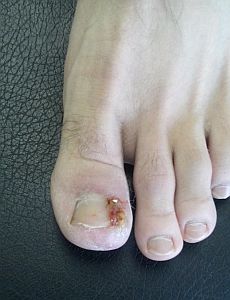
Stage three of ingrown toenail
Who to See for Ingrown Toenail Surgery
If you suffer from an ingrown toenail you should visit your physician. Depending on the local condition of your nail you will most likely be referred to a general surgeon or orthopedic surgeon for further treatment. Other times you may be referred to a podiatrist or ankle and foot surgeon who are more specialized for this type of condition. Also, in some cases a plastic surgeon might be a good choice for ingrown toenail surgery.
Types of Ingrown Toenail Surgery
1. Complete nail plate removal
Complete nail plate removal is not a complicated procedure and it can be done quickly. In the most cases, it can be finished in 15 – 20 minutes. But on the other hand, it is not a very effective surgical technique for an ingrown toenail. The only real indication is abscess formed on both sides of the nail which will not subside after partial nail plate removal. It can also be used after multiple unsuccessful partial removals of the nail plate.
The patient will most likely be lying down. The toe and distal part of the foot will be cleaned with antiseptic solution and draped. A local anesthetic will be used to anesthetize the toe. In the most cases, 1% solution of Lidocaine will be used. The patient should be asked before the start of the procedure if there are any allergic reactions to any anesthetics or other medicines. Digital block should be made by applying local anesthetic on the base of the finger on two spots. The patient will feel pain while injecting the anesthetic but after that, the pain will disappear and the patient should feel only touch and pressure but no pain. After that a Penrosse drain or a simple sterile glove can be wraped around the base of the toe and secured with a clamp or forceps to reduce bleeding. Hemostasis will help the surgeon to finish the procedure more quickly and accurately.
Before the start of the procedure, the patient can be asked if there is any pain while the doctor pinches inflammed toe with pincete. If the patient does not report any pain then the procedure can be started. A surgical instrument, for example, elevator or mosquito hemostat, will be inserted under the nail plate and pushed forward the base of the toe. That process should be repeated until the nail plate becomes loose. After that, the nail plate will be grasped and pulled distally until it is divided from the toe. The nail matrix, which is the part that generates new nail plate cells is now exposed. The toe should be cleaned with antiseptic solution and dressed using nonadherent vaseline gauze. On top of that a compression bandage should be applied.
This is not the best surgical technique for ingrown toenail(s) because the recurrence rate is very high. If the surgery is performed for the first time there is a chance of 32% up to 78% for recurrence. But if this procedure is done for the second time chances for recurrence are even higher, 70%-80%.
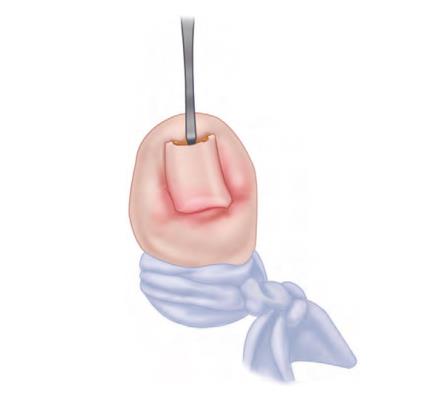
Complete nail plate removal, Ishikawa SN: Disorders of nails and skin, Figure 87-5, Chapter 87 in Campbell's Operative Orthopaedics 12th ed., 4120, 2013, Elsevier Inc.
2. Partial nail plate removal
Partial nail plate removal is almost the same procedure as complete nail plate removal. The only difference is that in this case only one part of the nail plate is removed. This procedure can be used for younger patients because it will not change the appearence of the nail permanently, although there is a chance of injuring the nail bed which will lead to deformations of the nail.
The surgical technique is almost the same as for complete nail plate removal. The patient should be prone. The distal part of the food should be well cleaned with antiseptic solution and draped. The toe should be anesthetized using local anesthetic, and after that hemostasis should be achieved using a glove or drain and a clamp.
When the doctor is sure that effect of the local anesthetic started, then the procedure should be started. Small surgical instrument such as elevator or mosquito hemostat will be placed under the nail plate on the side of inflammation. It will be used to elevate one quarter of the nail plate. After that scissors will be used to cut that part of the nail plate. It is important that the nail plate is cut all the way up to its origin, under the skin proximally on the toe. If there is any granulation tissue it will be removed using currete or excised. The toe will be cleaned once again before dressing with nonadherent vaseline gauze and compression bandage.
The recurrence of the ingrown nail after the partial nail plate removal is even higher than after the total nail plate removal. The only advantages are its simplicity, low chance of complications and maintaining the normal appearance of the nail.
3. Removal of the nail edge and ablation of the nail matrix
More aggressive surgical technique for ingrown toenail is ablation of the nail matrix. As mentioned earlier nail matrix is part of the nail which forms new nail plate cells. Ablation will destroy nail matrix and because of that, there will be no forming of cells of the nail plate.
Other names for this surgical technique are permanent or full nail avulsion or matrixetomy. It can be done completely or partially. Different methods can be used for ablation of the nail matrix. The most commonly used is phenol and that method is also known as phenolisation or full phenol avulsion.
Matrixetomy should be used in case of recurrent ingrown nails despite using nonsurgical methods or other surgical techniques for ingrown toenails. It is important that the patient understands that the nail plate will never again look the same as it was prior to ingrowing and infection.
If the matrixetomy is chosen for the treatment of ingrown toenail then total matrixetomy should be avoided if possible. Partial matrixetomy is the method of choice to try to preserve the structure of the remaining nail plate. Chemicals such as phenol, electrocauterization or surgery can be used for matrixetomy.
Phenol can be used for phenolisation also known as phenol avulsion. It is very common procedure for ingrown toenail. First part of procedure is the same as for partial or complete nail plate removal. The distal part of the food should be cleaned and draped. After that a digital block should be applied to anesthetize the toe and tournique, draine or glove to make hemostasis. A surgical instrument will be placed under the nail plate on the ingrown side and the nail plate will be elevated. It will be cut using scissors. After that, antibiotic gel should be applied to the skin surrounding the nail. It will protect the phenol to damage the skin. A cotton pledget which was previously dipped in phenol should be placed in the space where excised nail plate was. It should be rotated for a half a minute and the process repeated for 2-3 times. After that alcohol solution should be poured into the same space to neutralize the phenol. Nonadherent vaseline gauze and compression bandage should be used.
There are some reports that this method of treatment of ingrown toenails has a 98% success rate.
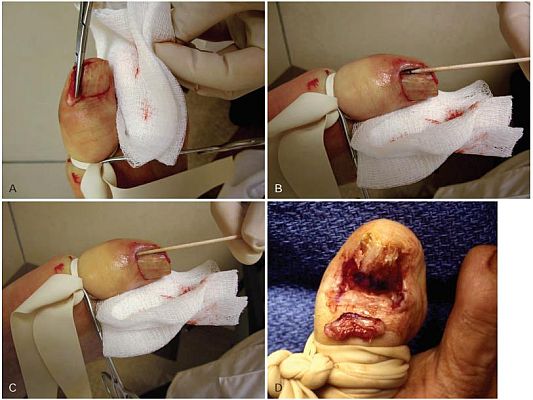
Removal of the nail edge and ablation of the nail matrix, Ishikawa SN: Disorders of nails and skin, Figure 87-9, Chapter 87 in Campbell's Operative Orthopaedics 12th ed., 4122, 2013, Elsevier Inc.
4. Electrodesiccation and curettage
Electrodesiccation and curettage is another surgical method for treatment of an ingrown toenail. It causes cutting away (ablation) of the nail matrix. Preparation is the same as for phenolisation. Also, partial or total nail plate removal should be done the same way as for phenolisation. After that tourniquet, glove or draine should be removed and extensive curettage of the exposed nail matrix should be done. The last part of treatment is electrodesiccation which will cause the destruction of the nail matrix. The electric current should be used for five seconds and after a break of 10-20 seconds it should be used again for five seconds.
5. Partial nail plate and matrix removal
This is one of the most commonly used surgical techniques for ingrown toenail. It is also called Lambiomatrixectomy Procedure or Winograd Technique, named after the surgeon who first described it. This technique can be used in cases of recurrence after partial or total nail plate removal.
The patient will be prone during procedure. Foot will be cleaned and the toe will be draped. After that digital block will be applied using 1% solution of Lidocaine. The effect of anesthetic would need a couple of minutes to start. During that period hemostasis can be obtained using tournique, Penrosse drain or glove and a clamp. After we are sure that the toe is anesthetized we can start by making an incision on the upper part of the nail (eponychium). The skin incision should start 5-8 mm above the upper edge of the nail and continue distally all the way to the distal edge of the nail. Nail plate should not be cut in this act. The part of the skin which was cut will be separated from the nail using a surgical instrument. After that the ingrown part of the nail will be detached and liberated from the skin using blunt surgical instrument like elevator or mosquito hemostat. When that part of the nail is elevated its one quarter should be cut using nail splitter. This will expose nail matrix which should also be removed to prevent nail plate from ingrowing. Nail matrix will be excised. Scalpel is used to achieve that. It is very important to make sure that all parts of nail matrix under the excised part of the nail plate are removed. The incised skin should be brought back to its original place. Sutures are optional. The final stage is dressing. Nonadherent gauze should be used for dressing.
Pettine et al. (1988) reported 6% recurrence rate for this surgical technique.

Partial nail plate and matrix removal, Ishikawa SN: Disorders of nails and skin, Figure 87-11, Chapter 87 in Campbell's Operative Orthopaedics 12th ed., 4123, 2013, Elsevier Inc.
6. Nail plate and germinal matrix removal
This is a more severe surgical technique which will cause the nail to stop growing ever again. It is indicated in middle-aged and older patients who suffer from recurrent ingrown toenail. It can also be used in younger patients which do not pay attention to the appearance of the toe.
This surgical technique is also known as Quenu, Zadik or Fowler technique. In some literature, it is known as surgical total matrixectomy or total nail ablation.
Preparations for this surgery are the same as for any other. Foot cleaning is followed by draping and applying local anesthetic and hemostasis. After that, the nail plate should be removed in total. After the nail plate has been removed two skin incisions should be made on the proximal edge of the nail bed. Incisions should be around 1 cm in length. When they are made, skin flap can be detached and retracted proximally.
On lateral sides of the nail 1 to 2 mm of skin should be excised. Then excision of the nail matrix can be started. It should be started on the distal part of the nail and continued proximally. Surgeon must be careful to excise all parts of nail matrix on lateral sides in grooves. For total excision of the nail matrix, tendon of big toe extensor muscle should be exposed together with fat and subcutaneous tissue. After the nail matrix has been excised in total, skin flap on the proximal part of the nail should be brought back to the place and sutured if it is needed. The final stage of surgery is dressing with nonadherent gauze.
Recurrence rates are different in literature. According to Townsend and Scott, in 59 % of patients a new nail was formed but only 10,4 % had symptoms recurrence. Other report shows only 4 % recurrence rate with 0% of symptoms recurrence (Murray, 1979). Compared to the total phenol ablation of the nail there is no significant difference between recurrence rates for both techniques.
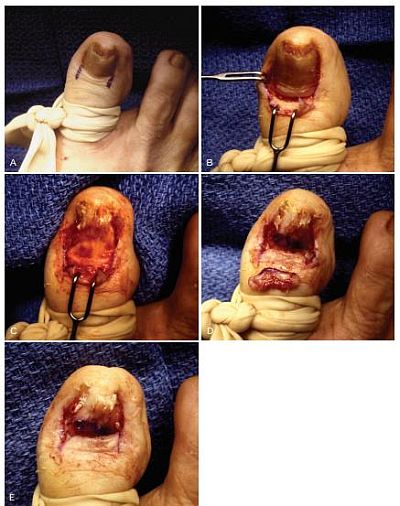
Nail plate and germinal matrix removal, Ishikawa SN: Disorders of nails and skin, Figure 87-12, Chapter 87 in Campbell's Operative Orthopaedics 12th ed., 4126, 2013, Elsevier Inc.
7. Partial nail fold and nail matrix removal
This technique is also known as wedge resection. In medical literature Watson-Cheyne and Burghard, O'Donoghue and Morgensen technique are different modifications of this technique. The main principle of this surgical technique is to remove all the bad tissue, which involves the ingrown part of the nail together with nail matrix and inflamed soft tissue on that side of the toe.
After the toe has been prepared for surgery, lateral quarter of the nail should be lifted using blunt surgical instrument and cut using scissors. Then skin incision should be made 1 cm above the upper edge of the nail and continued all the way to the lower edge of the nail. This incision runs parallel to the nail which was cut. The second incision should follow oblique border of the soft tissue which surrounds the nail. It should be at 45 degree angle and form a wedge with the first incision. That wedge should be removed. It contains inflamed soft tissue which surrounds the nail and nail matrix. It will prevent that lateral quarter of the nail from growing. Nonadherent vaseline gauze is used for dressing.
Dr Harry Gouvas procedure is another similar procedure. The 20% of the nail plate and nail matrix beneath it should be cut. It is important that all the infected skin which surrounds the ingrown nail is excised. After that sutures are used to close the wound.
There are several reports of recurrence rates of wedge resection. It goes from only 5% (Keyes, 1934) and up to 14% (Mogensen, 1971).

Wedge resection of ingrown toenail
8. Nail fold removal or reduction
When using this surgical procedure the nail itself will be spared form any surgical intervention. It might be a good surgical technique for patients concerned about final cosmetic results.
The whole procedure will be performed on a soft tissue of the toe. There are two main principles of this technique. First is to remove nail fold and normal soft tissue on border with nail fold and another is to remove wedge of soft tissue on the side of a toe without removing a nail fold. When this wedge is closed using sutures it will pull the skin form the ingrown nail and in that way increase the space between nail and skin and it will enable drainage.
Preparation for the surgery is the same as for other surgery techniques. If there is drainage from the ingrown nail then cultures should be collected using a swab. First step of procedure is making an skin incision. It should be ellipse shaped and started 4mm from the nail fold. Its size depends on the extent of ingrowing. Nail plate should be removed totally. For that elevator or mosquito hemostat can be used. After its removal, skin wedge should be removed. The wound should be sutured and on that way it will prevent newly formed nail form ingrowing.
In Barlet modification of this technique nail plate will not be removed. Only a skin wedge will be excised on a lateral side of a toe. After it is closed with sutures, the skin and nail fold will retract and release the lateral side of the nail.
In both Jansey and Bose modification nail plate and nail matrix will be preserved in total. Only a small skin wedge which contains nail fold will be excised. The wound will be sutured. Another similar procedure is the Vandenbos procedure. Almost the whole technique is the same. The only difference is that the skin wedge which contains nail fold will not be sutured after being cut. It will heal secondary.
According to Persichetti et al. (2004), recurrence rate is 5%,
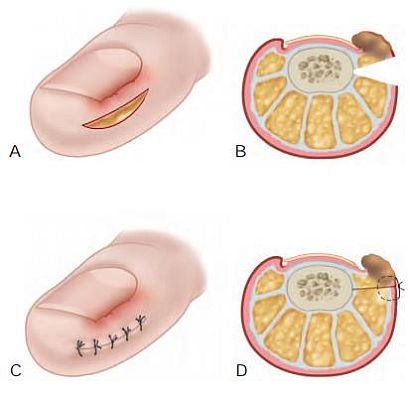
Nail fold removal, Ishikawa SN: Disorders of nails and skin, Figure 87-20, Chapter 87 in Campbell's Operative Orthopaedics 12th ed., 4129, 2013, Elsevier Inc.
9. Terminal syme procedure
Also known as Thompson-Terwilliger procedure is amputation of distal part of toes. Only the part of the toe which contains nail will be amputated. This procedure is indicated for adult patients with chronic and recurrent ingrown toenails and if every other surgical technique was unsuccessful.
The toe should be cleaned with antisepetic solution and draped after which anesthetic will be injected. Tournique can be used to help visualizing different parts of toe but it is not encouraged.
Skin incision should be made around the nail using a sharp blade. Proximally skin incision should go 6-7 mm above the nail edge and on sides for 4mm. Incision should be bone deep. Nail can be grasped using a clamp and detached form the toe. After that, bone (distal phalanx) will be cut using either a saw or bone nibbler. Hemostasis should be obtained using compression and wound should be sutured. After that the wound should be dressed.
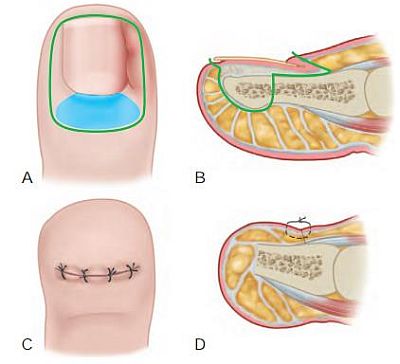
Terminal syme procedure, Ishikawa SN: Disorders of nails and skin, Figure 87-25, Chapter 87 in Campbell's Operative Orthopaedics 12th ed., 4131, 2013, Elsevier Inc.
References:
DermNet NZ. Ingrown toenails. DermNet NZ, 2013. Available from: www.dermnetnz.org/hair-nails-sweat/onychocryptosis.html (Accessed July, 2016).
Ishikawa SN: Disorders of nails and skin, Chapter 87 in Campbell's Operative Orthopaedics 12th ed., 4117-4130, 2013, Elsevier Inc.
Keyes EL: the surgical treatment of ingrown toenails, JAMA 102:1458, 1934.
Mogensen P: Ingrown toenail, Acta Orthop Scand 42:94, 1971.
Murray WR: Onychocryptosis: principles of non-operative and operative care. Clin Orthop Relat Res 142:96, 1979
Persichetti P, Simone P, Vecchi GL, et al: Wedge excision of the nail fold in the treatment of ingrown toenail, Ann Plast Surg 52:617, 2004.
Pettine KA, Cofield RH, Johnson KA, et al; Ingrown toenail: results of surgical treatment, Foot Ankle 9:130, 1988.
Townsend AC, Scott PR: Ingrown toenail and onychogryposis, J Bone Jint Surg 48B:354, 1996
If you're considering ingrown toenail surgery consider first what CurveCorrect can do for you.
Effective
CurveCorrect uses a method known as Orthonyxia to treat ingrown toenails. Clinical studies have proven it to be as effective as ingrown toenail surgery.
See how it works.
No Pain
CurveCorrect is completely non-invasive, a flexible brace applied to your toenail slowly works to reduce the curve of your nail. Surgery for ingrown toenails involves numbing the toe, cutting off the sides of your toenail back all the way under the skin and treating the matrix to prevent the nail from growing back.
No Recovery
Because CurveCorrect is non-invasive there is no recovery. You'll need at least 4 weeks to completely heal from ingrown toenail surgery. Missing work, limited mobility, painkilling drugs, foot soaking, changing bandages frequently and return doctor visits to remove stitches may all be required post ingrown toenail surgery.
No Disfigurement
CurveCorrect simply corrects the curve of your toenail, you retain your complete nail as nature intended. Ingrown toenail surgery leaves your toenail much more narrow than before and unnatural in appearance.
No Office Visit
You can apply CurveCorrect yourself at your convenience. Ingrown toenail surgery is an outpatient surgical procedure.
Privacy
You can apply CurveCorrect in the privacy of your own home. Ingrown toenail surgery will require more than one office visit.
Correct Toenail Curvature
Ingrown toenails are the result of a toenail that has become excessively curved. CurveCorrect addresses the root problem, the curve of your toenail. Ingrown toenail surgery attempts to solve the same problem by removing the curved part of your toenail. There is no ingrown toenail surgery available to correct toenail curvature.
Treatment Time
It takes just a few minutes to apply CurveCorrect once every 4-6 weeks. After a few treatments most users can stop while some will need to occasionally reapply CurveCorrect to maintain correction. Ingrown toenail surgery is an actual surgical procedure that requires at least 90 minutes.
Cost
CurveCorrect costs less than 10% of what you'll pay to undergo surgery for ingrown toenails.
Chance of Recurrence
Clinical studies show the chance of your ingrown toenail returning after treatment is only slightly more than ingrown toenail surgery. 13% vs. 11%.
90 Day Money-Back Guarantee
If you're unhappy with our product for any reason we'll give your money back, plus pay return shipping for up to 90 days after your order. We have maximum confidence that our product delivers results. Our Guarantee.
Customer Service
We make supporting our customers after the sale a priority. If you ever need anything please contact us at 1-833-840-4320 or email.

